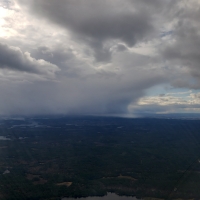Power Settings For PA28R-200
I have a 1976 Arrow II. PA28R-200. When I bought it the propeller was changed to a three blade Hartzell.
I never really cared too much about the benefits of fuel / power settings.
I run 24/24 in cruise and this is the way I was taught. I was told that 24/24 is 75%. Is this correct?
Obviously the power settings in the POH don’t come into play.
Is there anyone that actually has the cruise settings for my plane?


Comments
3 blade vs 2 blade it is going to be about the same and I would use book values.
I would expect you would climb faster, cruise a bit slower and that it would be smoother overall vs 2 blade.
24/24 is about 75%. Depends on the altitude and it looks like above 4,000 ft you are going to be below 75% unless there are alternate rpm settings for cruise. The seems a little odd to me as normally asperated planes can typically do 75% up to around 7500 ft.
The performance chart differs from the cruise chart and shows 75% up to 6500 ft.
Eric Panning
1981 Seneca III
Hillsboro, OR (KHIO)
Thank you for that, they are the charts I have in my POH.
My understanding was that they were some how different. I do know that with the 2 blade prop there were certain combinations that couldn't be used due to harmonic vibrations that don't exist with the 3 blade prop.
I currently use Full power on takeoff, 25/25 on climb and 24/24 or 23/23 on cruise.
Seem to work.
My guess is you climb about 100 fpm better than POH and are about 2 kts slower.
You can use the identical power settings as in the POH as they dependent on the engine vs prop config.
Have fun!
Eric Panning
1981 Seneca III
Hillsboro, OR (KHIO)
To better frame the overall response, will help to have a bit more context to "I never really cared too much about the benefits of fuel / power settings."
Some people fly based on speed and not range, yet the end goal should focus on engine longevity. Related, does the plane have any of the newer aftermarket instrumentation such as a multi probe engine analyzer, or is it still original with things like a single probe EGT? Also, if not already done, might consider cross checking against the engine's POH.
As a possible crude and non applicable analogy, based on details in sales listings, am seeing that the turbo variants tend to need overhaul / replacement by TBO (if they make it that far). Continental, Lycoming, 4 cylinder, 6 cylinder, 2 blade, 3 blade, single turbo, dual turbos does not matter. These planes typically cruise at ~75% power per POH and my perspective is that there is a correlation of not getting past TBO. The engine in mine did not make it to TBO and it is normally aspirated (but I do not know how the previous owners managed power although there is strong evidence that it was previously used for business). Point is, if the analogy applies, just make sure to budget accordingly and get the best data available.
While also focusing on the speed aspect, and at the risk of insulting, not all pilots keep V speeds in the forethought when entering non-smooth air. Once hitting turbulence (or better yet before getting to an area with known / predicted turbulence), the higher cruise speeds have to get tossed in favor of structural speed limitations which are likely less than 75% power.